2016 MERCEDES-BENZ CLS change wheel
[x] Cancel search: change wheelPage 21 of 342
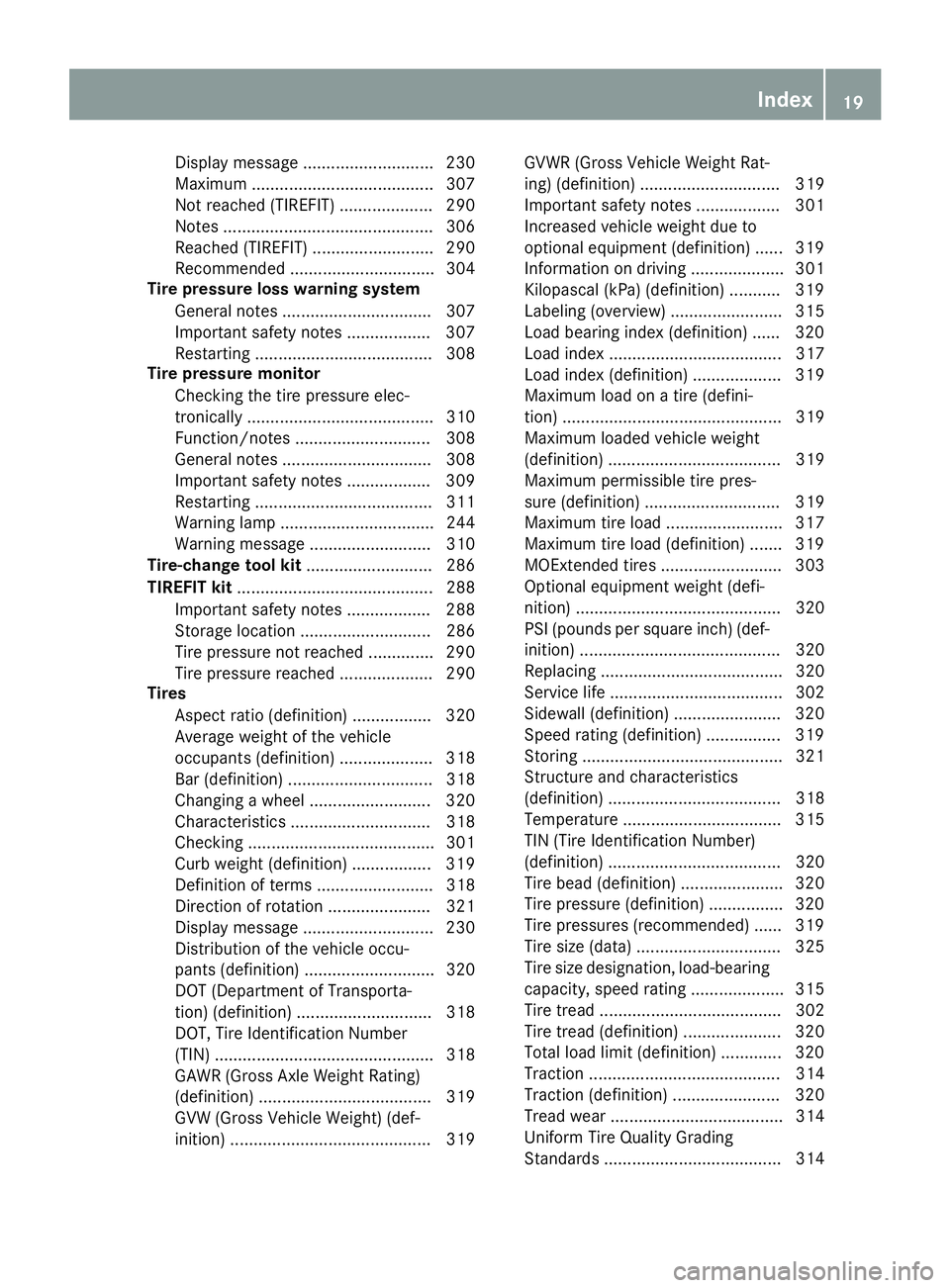
Display message ............................ 230
Maximum ....................................... 307
Not reached (TIREFIT) .................... 290
Notes ............................................. 306
Reached (TIREFIT) .......................... 290
Recommended ............................... 304
Tire pressure loss warning system
General notes ................................ 307
Important safety notes .................. 307
Restarting ...................................... 308
Tire pressure monitor
Checking the tire pressure elec-
tronically ........................................ 310
Function/notes ............................. 308
General notes ................................ 308
Important safety notes .................. 309
Restarting ...................................... 311
Warning lamp ................................. 244
Warning message .......................... 310
Tire-change tool kit ........................... 286
TIREFIT kit .......................................... 288
Important safety notes .................. 288
Storage location ............................ 286
Tire pressure not reached .............. 290
Tire pressure reached .................... 290
Tires
Aspect ratio (definition) ................. 320
Average weight of the vehicle
occupants (definition) .................... 318
Bar (definition) ............................... 318
Changing a wheel .......................... 320
Characteristics .............................. 318
Checking ........................................ 301
Curb weight (definition) ................. 319
Definition of terms ......................... 318
Direction of rotation ...................... 321
Display message ............................ 230
Distribution of the vehicle occu-
pants (definition) ............................ 320
DOT (Department of Transporta-
tion) (definition) ............................. 318
DOT, Tire Identification Number
(TIN) ............................................... 318
GAWR (Gross Axle Weight Rating)
(definition) ..................................... 319
GVW (Gross Vehicle Weight) (def-
inition) ........................................... 319 GVWR (Gross Vehicle Weight Rat-
ing) (definition) .............................. 319
Important safety notes .................. 301
Increased vehicle wei ght due to
o ptional equipment (definition) ...... 319
Information on driving .................... 301
Kilopascal (kPa) (definition) ........... 319
Labeling (overview) ........................ 315
Load bearing index (definition) ...... 320
Load index ..................................... 317
Load index (definition) ................... 319
Maximum load on a tire (defini-
tion) ............................................... 319
Maximum loaded vehicle weight
(definition) ..................................... 319
Maximum permissible tire pres-
sure (definition) ............................. 319
Maximum tire load ......................... 317
Maximum tire load (definition) ....... 319
MOExtended tires .......................... 303
Optional equipment weight (defi-
nition) ............................................ 320
PSI (pounds per square inch) (def-
inition) ........................................... 320
Replacing ....................................... 320
Service life ..................................... 302
Sidewall (definition) ....................... 320
Speed rating (definition) ................ 319
Storing ........................................... 321
Structure and characteristics
(definition) ..................................... 318
Temperature .................................. 315
TIN (Tire Identification Number)
(definition) ..................................... 320
Tire bead (definition) ...................... 320
Tire pressure (definition) ................ 320
Tire pressures (recommended) ...... 319
Tire size (data) ............................... 325
Tire size designation, load-bearing
capacity, speed rating .................... 315
Tire tread ....................................... 302
Tire tread (definition) ..................... 320
Total load limit (definition) ............. 320
Traction ......................................... 314
Traction (definition) ....................... 320
Tread wear ..................................... 314
Uniform Tire Quality Grading
Standards ...................................... 314 Index 19
Page 30 of 342
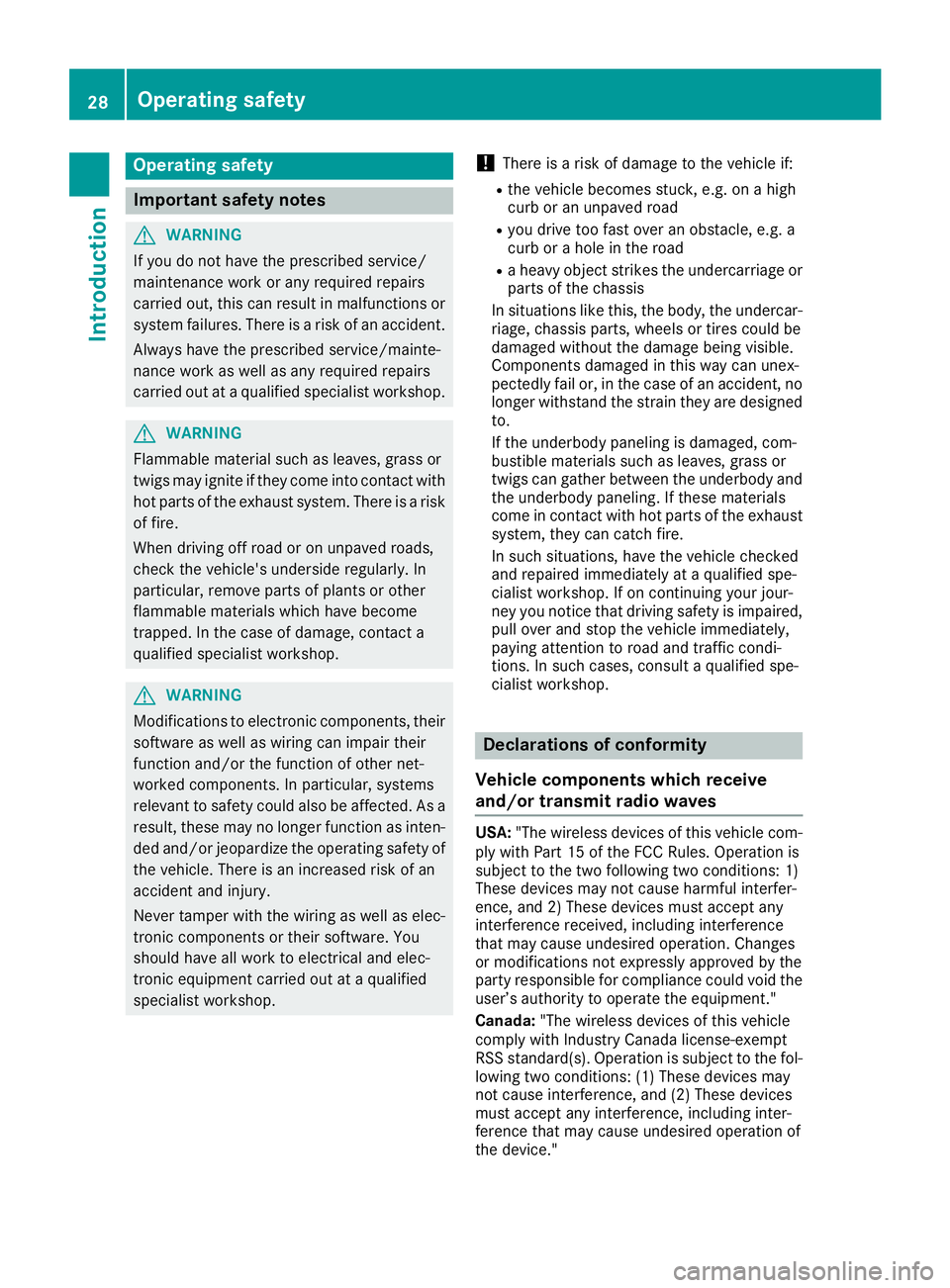
Operating safety
Important safety notes
G WARNING
If you do not have the prescribed service/
maintenance work or any required repairs
carried out, this can result in malfunctions or
system failures. There is a risk of an accident.
Always have the prescribed service/mainte-
nance work as well as any required repairs
carried out at a qualified specialist workshop.
G WARNING
Flammable material such as leaves, grass or
twigs may ignite if they come into contact with
hot parts of the exhaust system. There is a risk
of fire.
When driving off road or on unpaved roads,
check the vehicle's underside regularly. In
particular, remove parts of plants or other
flammable materials which have become
trapped. In the case of damage, contact a
qualified specialist workshop.
G WARNING
Modifications to electronic components, their
software as well as wiring can impair their
function and/or the function of other net-
worked components. In particular, systems
relevant to safety could also be affected. As a
result, these may no longer function as inten-
ded and/or jeopardize the operating safety of
the vehicle. There is an increased risk of an
accident and injury.
Never tamper with the wiring as well as elec-
tronic components or their software. You
should have all work to electrical and elec-
tronic equipment carried out at a qualified
specialist workshop. ! There is a risk of damage to the vehicle if: R
the vehicle becomes stuck, e.g. on a high
curb or an unpaved road R
you drive too fast over an obstacle, e.g. a
curb or a hole in the road R
a heavy object strikes the undercarriage or
parts of the chassis
In situations like this, the body, the undercar-
riage, chassis parts, wheels or tires could be
damaged without the damage being visible.
Components damaged in this way can unex-
pectedly fail or, in the case of an accident, no
longer withstand the strain they are designed
to.
If the underbody paneling is damaged, com-
bustible materials such as leaves, grass or
twigs can gather between the underbody and
the underbody paneling. If these materials
come in contact with hot parts of the exhaust
system, they can catch fire.
In such situations, have the vehicle checked
and repaired immediately at a qualified spe-
cialist workshop. If on continuing your jour-
ney you notice that driving safety is impaired,
pull over and stop the vehicle immediately,
paying attention to road and traffic condi-
tions. In such cases, consult a qualified spe-
cialist workshop.
Declarations of conformity
Vehicle components which receive
and/or transmit radio waves USA: "The wireless devices of this vehicle com-
ply with Part 15 of the FCC Rules. Operation is
subject to the two following two conditions: 1)
These devices may not cause harmful interfer-
ence, and 2) These devices must accept any
interference received, including interference
that may cause undesired operation. Changes
or modifications not expressly approved by the
party responsible for compliance could void the
user’s authority to operate the equipment."
Canada: "The wireless devices of this vehicle
comply with Industry Canada license-exempt
RSS standard(s). Operation is subject to the fol-
lowing two conditions: (1) These devices may
not cause interference, and (2) These devices
must accept any interference, including inter-
ference that may cause undesired operation of
the device."28
Operating safety
Introduction
Page 111 of 342
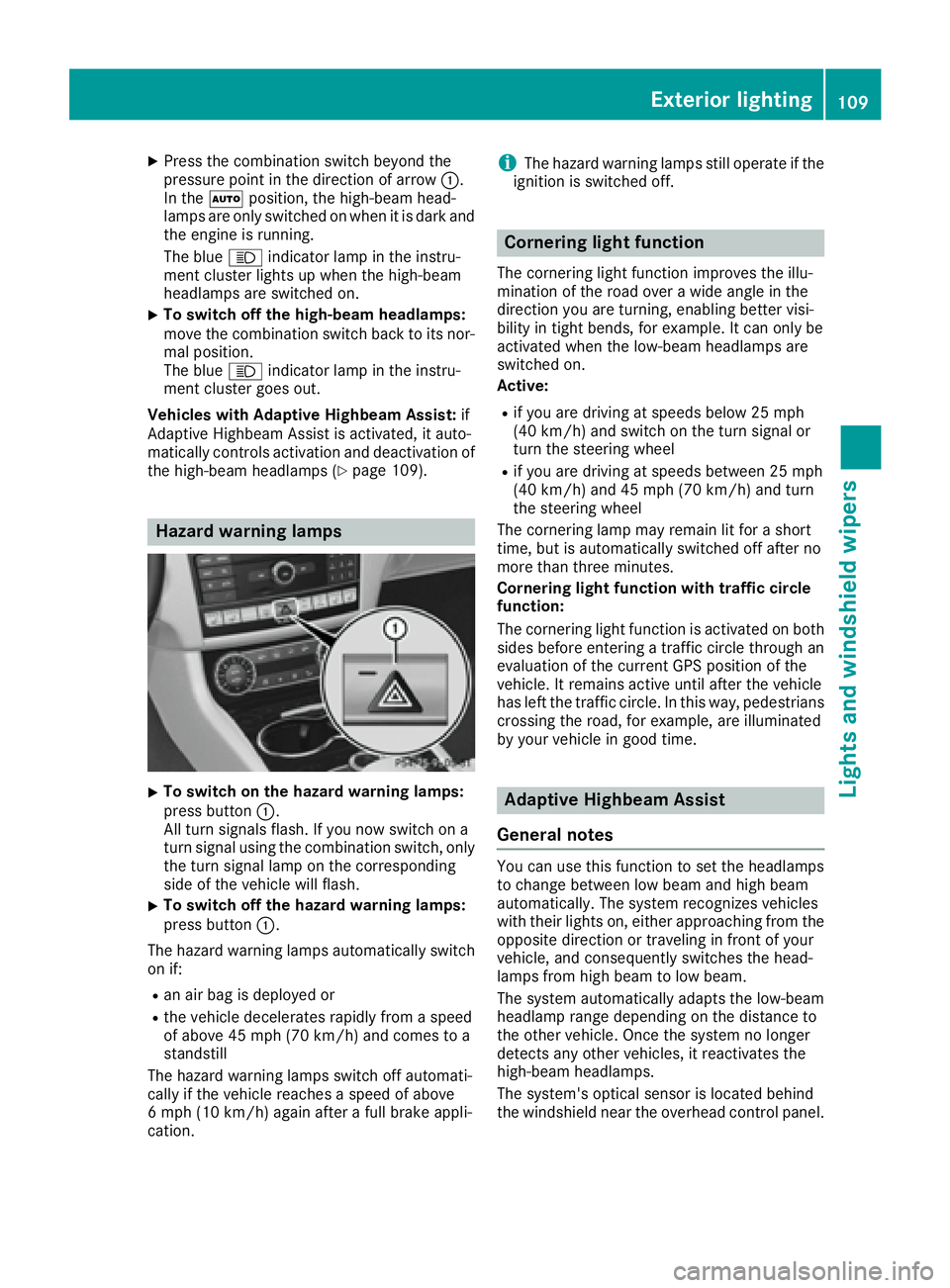
X
Press the combination switch beyond the
pressure point in the direction of arrow �C .
In the �X position, the high-beam head-
lamps are only switched on when it is dark and
the engine is running.
The blue �W indicator lamp in the instru-
ment cluster lights up when the high-beam
headlamps are switched on. X
To switch off the high-beam headlamps:
move the combination switch back to its nor-
mal position.
The blue �W indicator lamp in the instru-
ment cluster goes out.
Vehicles with Adaptive Highbeam Assist: if
Adaptive Highbeam Assist is activated, it auto-
matically controls activation and deactivation of
the high-beam headlamps ( Y
page 109).
Hazard warning lamps
X
To switch on the hazard warning lamps:
press button �C .
All turn signals flash. If you now switch on a
turn signal using the combination switch, only
the turn signal lamp on the corresponding
side of the vehicle will flash. X
To switch off the hazard warning lamps:
press button �C .
The hazard warning lamps automatically switch
on if: R
an air bag is deployed or R
the vehicle decelerates rapidly from a speed
of above 45 mph (70 km/h) and comes to a
standstill
The hazard warning lamps switch off automati-
cally if the vehicle reaches a speed of above
6 mph (10 km/h) again after a full brake appli-
cation. i The hazard warning lamps still operate if the
ignition is switched off.
Cornering light function The cornering light function improves the illu-
mination of the road over a wide angle in the
direction you are turning, enabling better visi-
bility in tight bends, for example. It can only be
activated when the low-beam headlamps are
switched on.
Active: R
if you are driving at speeds below 25 mph
(40 km/h) and switch on the turn signal or
turn the steering wheel R
if you are driving at speeds between 25 mph
(40 km/h) and 45 mph (70 km/h) and turn
the steering wheel
The cornering lamp may remain lit for a short
time, but is automatically switched off after no
more than three minutes.
Cornering light function with traffic circle
function:
The cornering light function is activated on both
sides before entering a traffic circle through an
evaluation of the current GPS position of the
vehicle. It remains active until after the vehicle
has left the traffic circle. In this way, pedestrians
crossing the road, for example, are illuminated
by your vehicle in good time.
Adaptive Highbeam Assist
General notes You can use this function to set the headlamps
to change between low beam and high beam
automatically. The system recognizes vehicles
with their lights on, either approaching from the
opposite direction or traveling in front of your
vehicle, and consequently switches the head-
lamps from high beam to low beam.
The system automatically adapts the low-beam
headlamp range depending on the distance to
the other vehicle. Once the system no longer
detects any other vehicles, it reactivates the
high-beam headlamps.
The system's optical sensor is located behind
the windshield near the overhead control panel.Exterior lighting 109
Lights and windshield wipers Z
Page 139 of 342
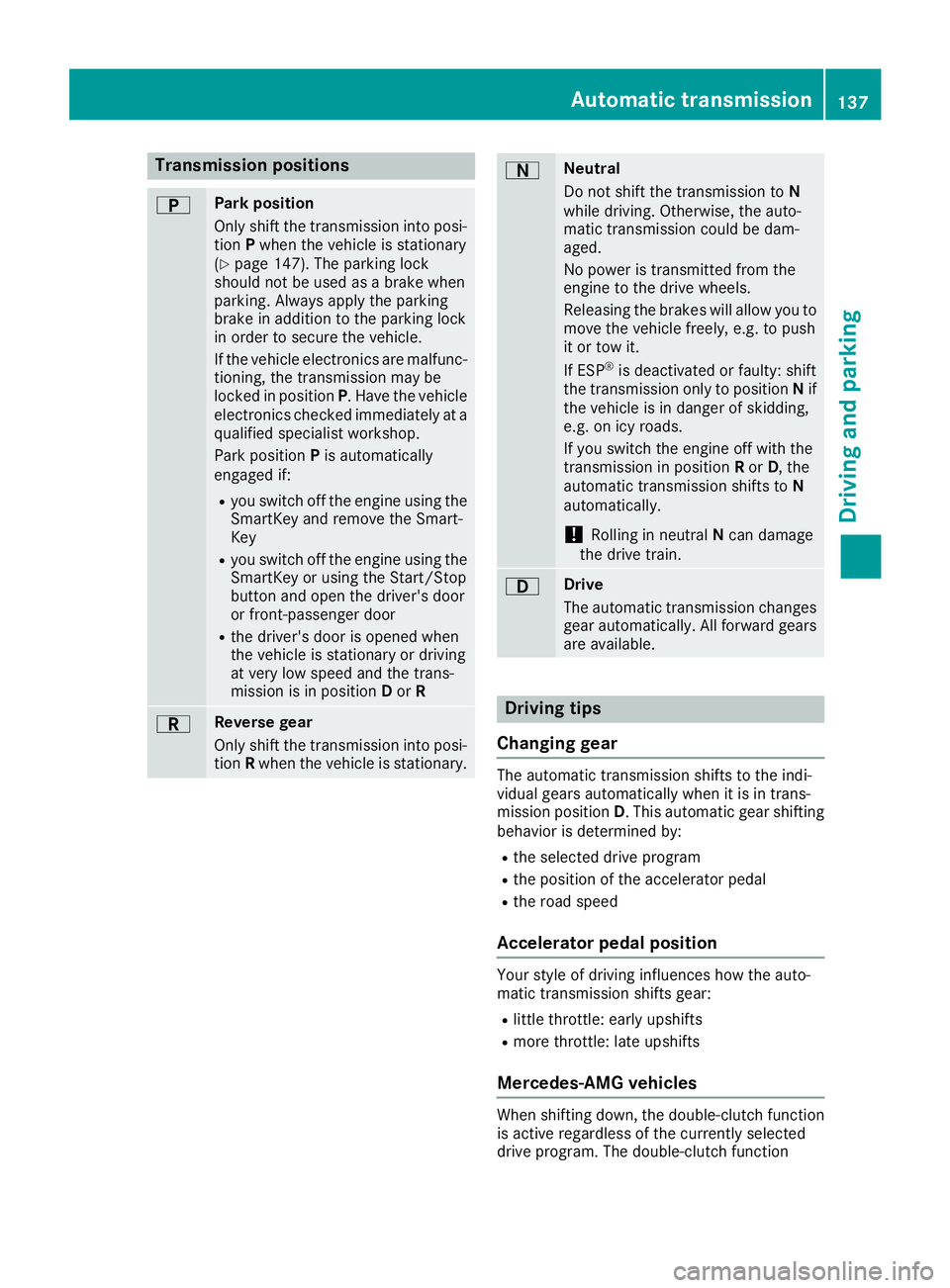
Transmission positions �E Park position
Only shift the transmission into posi-
tion P when the vehicle is stationary
( Y
page 147). The parking lock
should not be used as a brake when
parking. Always apply the parking
brake in addition to the parking lock
in order to secure the vehicle.
If the vehicle electronics are malfunc-
tioning, the transmission may be
locked in position P . Have the vehicle
electronics checked immediately at a
qualified specialist workshop.
Park position P is automatically
engaged if: R
you switch off the engine using the
SmartKey and remove the Smart-
Key R
you switch off the engine using the
SmartKey or using the Start/Stop
button and open the driver's door
or front-passenger door R
the driver's door is opened when
the vehicle is stationary or driving
at very low speed and the trans-
mission is in position D or R
�F Reverse gear
Only shift the transmission into posi-
tion R when the vehicle is stationary. �D Neutral
Do not shift the transmission to N
while driving. Otherwise, the auto-
matic transmission could be dam-
aged.
No power is transmitted from the
engine to the drive wheels.
Releasing the brakes will allow you to
move the vehicle freely, e.g. to push
it or tow it.
If ESP ®
is deactivated or faulty: shift
the transmission only to position N if
the vehicle is in danger of skidding,
e.g. on icy roads.
If you switch the engine off with the
transmission in position R or D , the
automatic transmission shifts to N
automatically.
! Rolling in neutral N can damage
the drive train.
�: Drive
The automatic transmission changes
gear automatically. All forward gears
are available.
Driving tips
Changing gear The automatic transmission shifts to the indi-
vidual gears automatically when it is in trans-
mission position D . This automatic gear shifting
behavior is determined by: R
the selected drive program R
the position of the accelerator pedal R
the road speed
Accelerator pedal position Your style of driving influences how the auto-
matic transmission shifts gear: R
little throttle: early upshifts R
more throttle: late upshifts
Mercedes-AMG vehicles
When shifting down, the double-clutch function
is active regardless of the currently selected
drive program. The double-clutch functionAutomatic transmission 137
Driving an d parking Z
Page 141 of 342
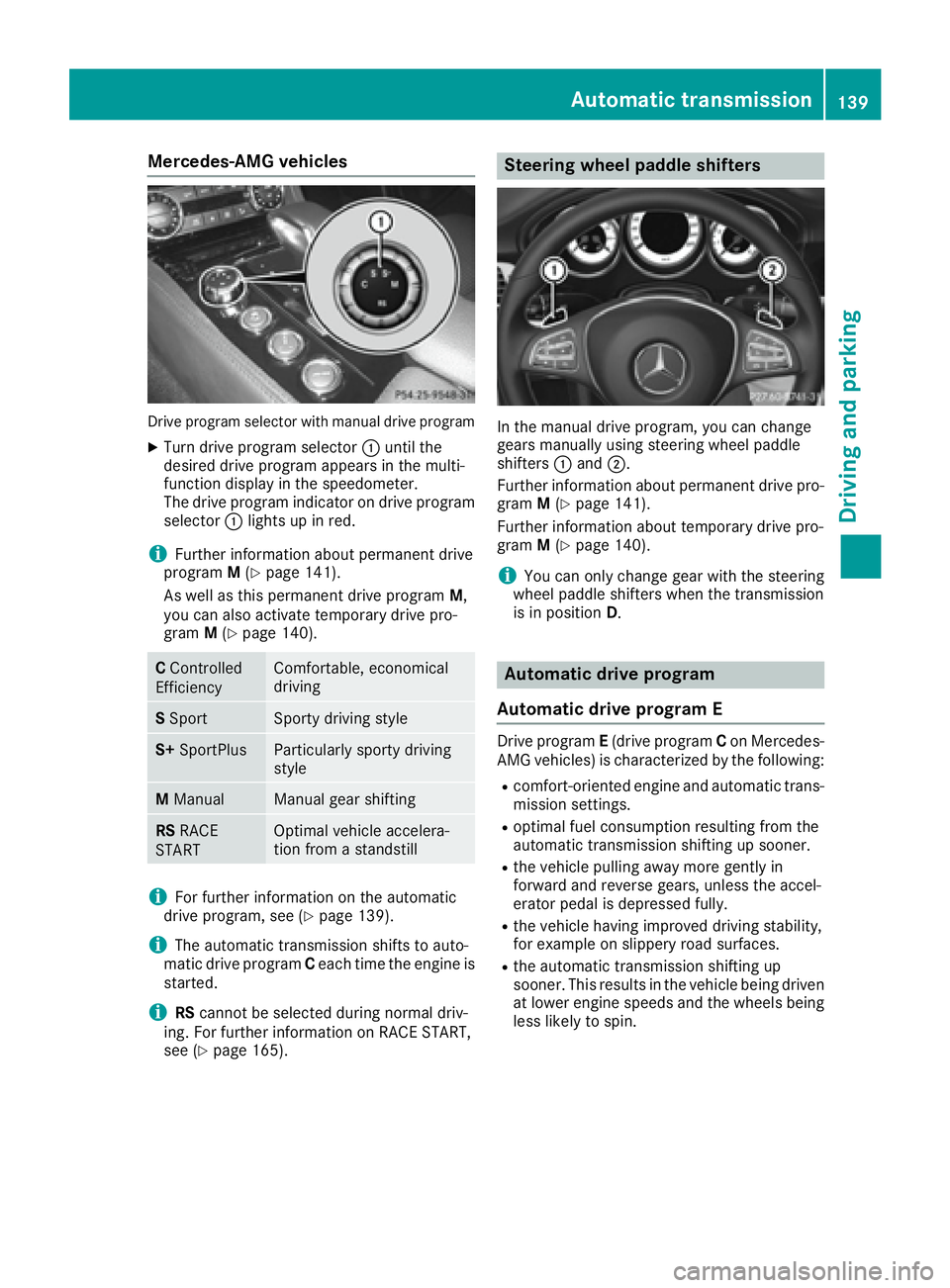
Mercedes-AMG vehicles
Drive program selector with manual drive program X
Turn drive program selector �C until the
desired drive program appears in the multi-
function display in the speedometer.
The drive program indicator on drive program
selector �C lights up in red.
i Further information about permanent drive
program M ( Y
page 141).
As well as this permanent drive program M ,
you can also activate temporary drive pro-
gram M ( Y
page 140).
C Controlled
Efficiency Comfortable, economical
driving
S Sport Sporty driving style
S+ SportPlus Particularly sporty driving
style
M Manual Manual gear shifting
RS RACE
START Optimal vehicle accelera-
tion from a standstill
i For further information on the automatic
drive program, see ( Y
page 139).
i The automatic transmission shifts to auto-
matic drive program C each time the engine is
started.
i RS cannot be selected during normal driv-
ing. For further information on RACE START,
see ( Y
page 165). Steering wheel paddle shifters
In the manual drive program, you can change
gears manually using steering wheel paddle
shifters �C and �D .
Further information about permanent drive pro-
gram M ( Y
page 141).
Further information about temporary drive pro-
gram M ( Y
page 140).
i You can only change gear with the steering
wheel paddle shifters when the transmission
is in position D .
Automatic drive program
Automatic drive program E Drive program E (drive program C on Mercedes-
AMG vehicles) is characterized by the following: R
comfort-oriented engine and automatic trans-
mission settings. R
optimal fuel consumption resulting from the
automatic transmission shifting up sooner. R
the vehicle pulling away more gently in
forward and reverse gears, unless the accel-
erator pedal is depressed fully. R
the vehicle having improved driving stability,
for example on slippery road surfaces. R
the automatic transmission shifting up
sooner. This results in the vehicle being driven
at lower engine speeds and the wheels being
less likely to spin.Automatic transmission 139
Driving and parking Z
Page 143 of 342
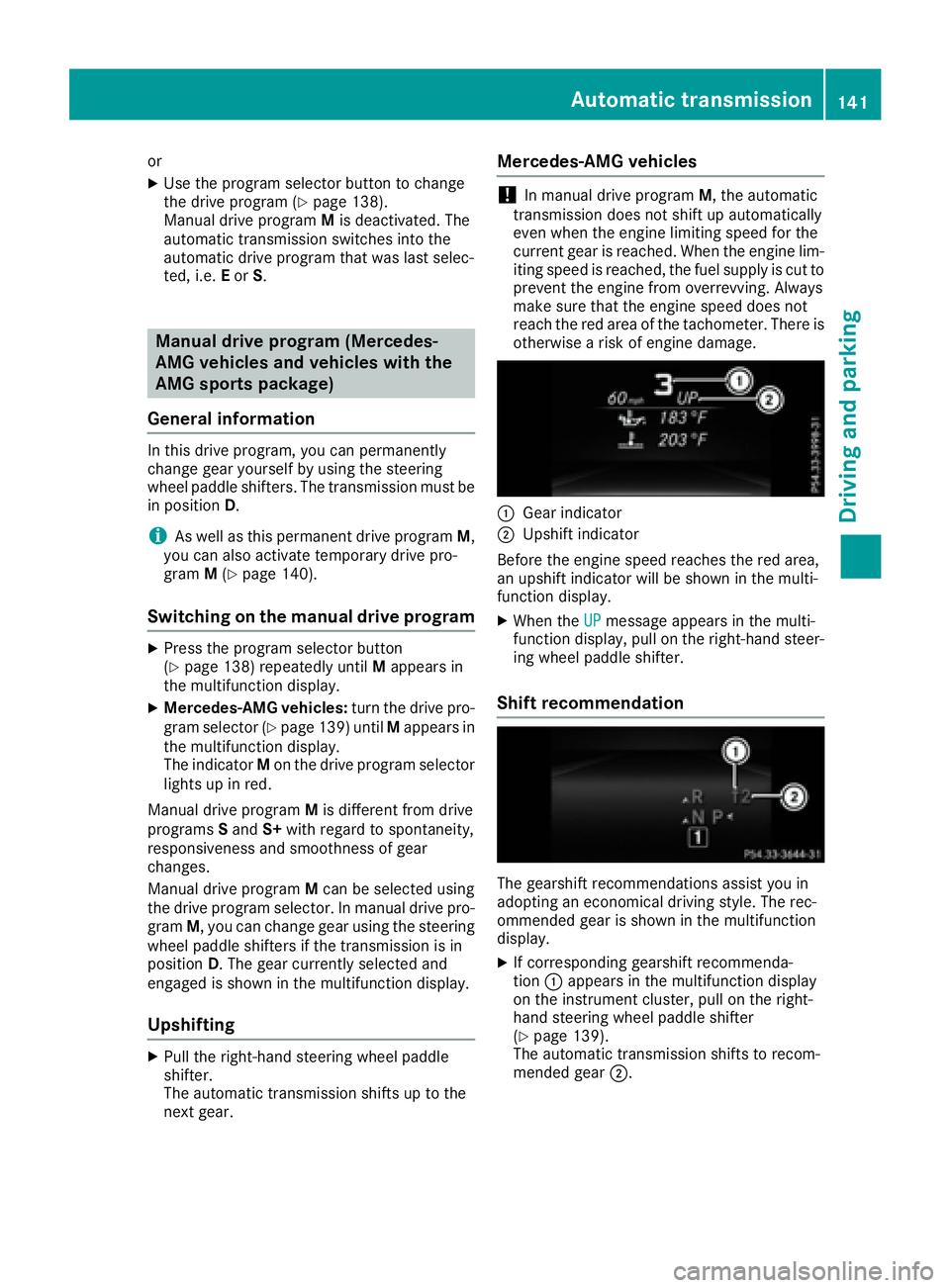
or X
Use the program selector button to change
the drive program ( Y
page 138).
Manual drive program M is deactivated. The
automatic transmission switches into the
automatic drive program that was last selec-
ted, i.e. E or S .
Manual drive program (Mercedes-
AMG vehicles and vehicles with the
AMG sports package)
General information In this drive program, you can permanently
change gear yourself by using the steering
wheel paddle shifters. The transmission must be
in position D .
i As well as this permanent drive program M ,
you can also activate temporary drive pro-
gram M ( Y
page 140).
Switching on the manual drive program X
Press the program selector button
( Y
page 138) repeatedly until M appears in
the multifunction display. X
Mercedes-AMG vehicles: turn the drive pro-
gram selector ( Y
page 139) until M appears in
the multifunction display.
The indicator M on the drive program selector
lights up in red.
Manual drive program M is different from drive
programs S and S+ with regard to spontaneity,
responsiveness and smoothness of gear
changes.
Manual drive program M can be selected using
the drive program selector. In manual drive pro-
gram M , you can change gear using the steering
wheel paddle shifters if the transmission is in
position D . The gear currently selected and
engaged is shown in the multifunction display.
Upshifting X
Pull the right-hand steering wheel paddle
shifter.
The automatic transmission shifts up to the
next gear. Mercedes-AMG vehicles
! In manual drive program M , the automatic
transmission does not shift up automatically
even when the engine limiting speed for the
current gear is reached. When the engine lim-
iting speed is reached, the fuel supply is cut to
prevent the engine from overrevving. Always
make sure that the engine speed does not
reach the red area of the tachometer. There is
otherwise a risk of engine damage.
�C
Gear indicator �D
Upshift indicator
Before the engine speed reaches the red area,
an upshift indicator will be shown in the multi-
function display. X
When the UP message appears in the multi-
function display, pull on the right-hand steer-
ing wheel paddle shifter.
Shift recommendation
The gearshift recommendations assist you in
adopting an economical driving style. The rec-
ommended gear is shown in the multifunction
display. X
If corresponding gearshift recommenda-
tion �C appears in the multifunction display
on the instrument cluster, pull on the right-
hand steering wheel paddle shifter
( Y
page 139).
The automatic transmission shifts to recom-
mended gear �D .Automatic transmission 141
Driving and parking Z
Page 152 of 342
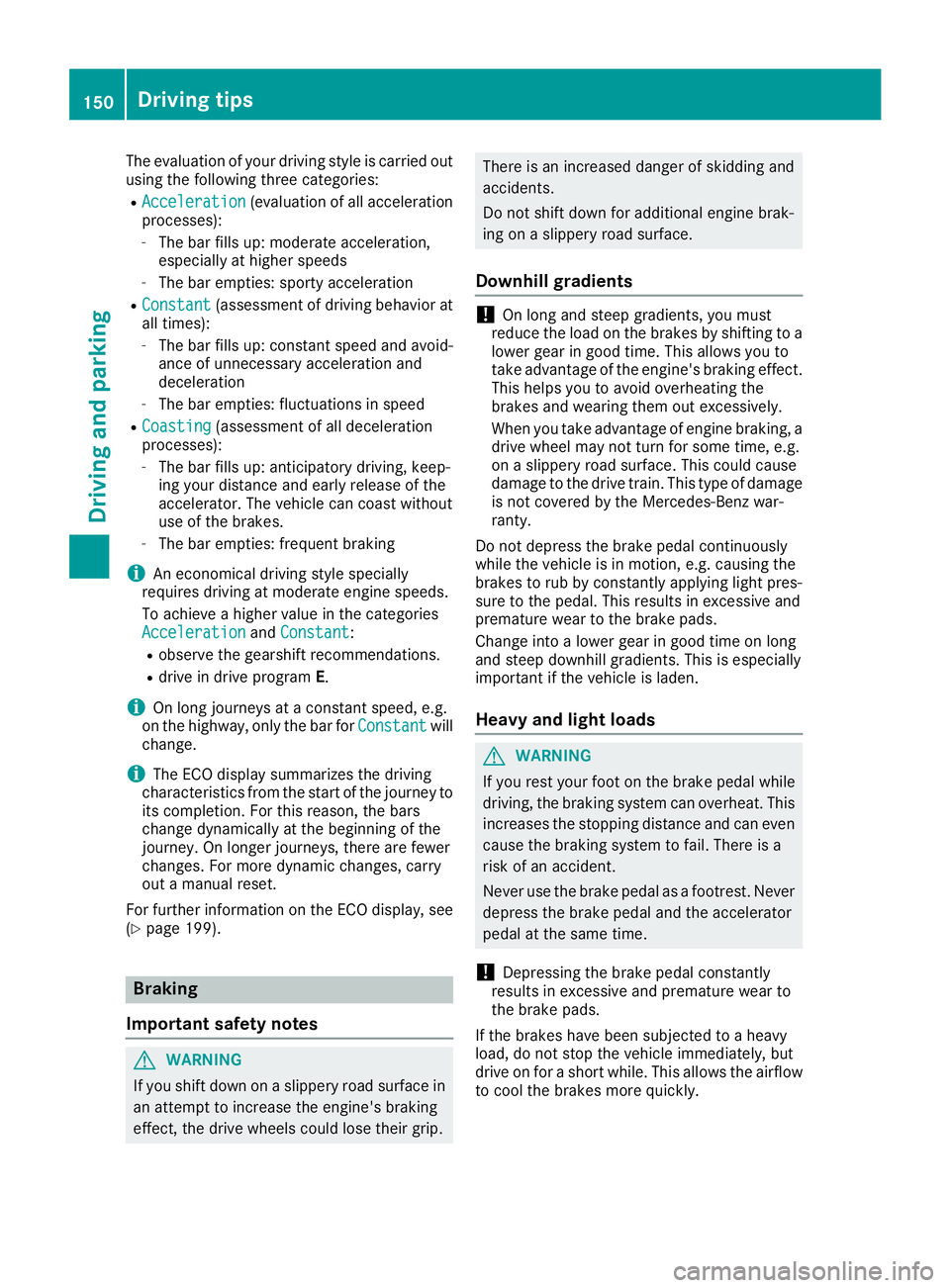
The evaluation of your driving style is carried out
using the following three categories: R
Acceleration (evaluation of all acceleration
processes): -
The bar fills up: moderate acceleration,
especially at higher speeds -
The bar empties: sporty acceleration R
Constant (assessment of driving behavior at
all times): -
The bar fills up: constant speed and avoid-
ance of unnecessary acceleration and
deceleration -
The bar empties: fluctuations in speed R
Coasting (assessment of all deceleration
processes): -
The bar fills up: anticipatory driving, keep-
ing your distance and early release of the
accelerator. The vehicle can coast without
use of the brakes. -
The bar empties: frequent braking
i An economical driving style specially
requires driving at moderate engine speeds.
To achieve a higher value in the categories
Acceleration and Constant :R
observe the gearshift recommendations. R
drive in drive program E .
i On long journeys at a constant speed, e.g.
on the highway, only the bar for Constant will
change.
i The ECO display summarizes the driving
characteristics from the start of the journey to
its completion. For this reason, the bars
change dynamically at the beginning of the
journey. On longer journeys, there are fewer
changes. For more dynamic changes, carry
out a manual reset.
For further information on the ECO display, see
( Y
page 199).
Braking
Important safety notes
G WARNING
If you shift down on a slippery road surface in
an attempt to increase the engine's braking
effect, the drive wheels could lose their grip. There is an increased danger of skidding and
accidents.
Do not shift down for additional engine brak-
ing on a slippery road surface.
Downhill gradients
! On long and steep gradients, you must
reduce the load on the brakes by shifting to a
lower gear in good time. This allows you to
take advantage of the engine's braking effect.
This helps you to avoid overheating the
brakes and wearing them out excessively.
When you take advantage of engine braking, a
drive wheel may not turn for some time, e.g.
on a slippery road surface. This could cause
damage to the drive train. This type of damage
is not covered by the Mercedes-Benz war-
ranty.
Do not depress the brake pedal continuously
while the vehicle is in motion, e.g. causing the
brakes to rub by constantly applying light pres-
sure to the pedal. This results in excessive and
premature wear to the brake pads.
Change into a lower gear in good time on long
and steep downhill gradients. This is especially
important if the vehicle is laden.
Heavy and light loads
G WARNING
If you rest your foot on the brake pedal while
driving, the braking system can overheat. This
increases the stopping distance and can even
cause the braking system to fail. There is a
risk of an accident.
Never use the brake pedal as a footrest. Never
depress the brake pedal and the accelerator
pedal at the same time.
! Depressing the brake pedal constantly
results in excessive and premature wear to
the brake pads.
If the brakes have been subjected to a heavy
load, do not stop the vehicle immediately, but
drive on for a short while. This allows the airflow
to cool the brakes more quickly.150
Driving tips
Driving and parking
Page 155 of 342
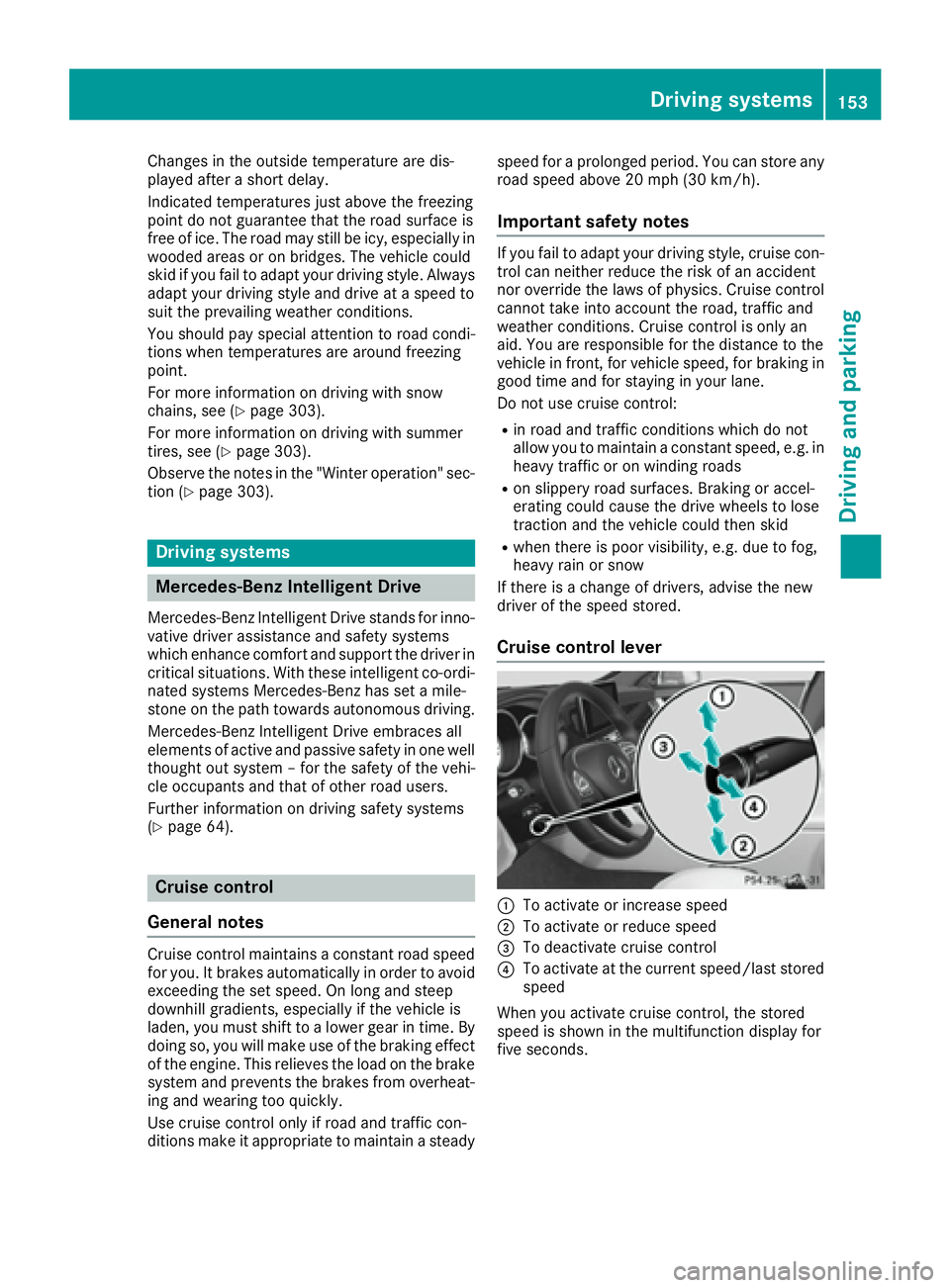
Changes in the out side temperature are dis-
played after a short delay.
Indic ated temperatures just above the freezing
poin t do not guarantee that the road surface is
free of ice. The road may st ill be icy, especially in
wooded areas or on brid ges. The veh icle could
sk id if you fail to adapt your driv ing style. Alwa ys
adapt your driv ing style and driv e at a speed to
suit the pre vailin g weather conditions.
You should pay special attention to road condi-
tions when temperatures are around freezing
poin t.
For more information on driv ing wit h snow
chains, see ( Y
page 303).
For more information on driv ing wit h summer
tires, see ( Y
page 303).
Observe the notes in the "Win ter operation" sec-
tion ( Y
page 303).
Driving systems
Mercedes-Benz Intelligent Drive Mercedes-Benz In te lligen t Drive stands for inno-
vative driv er assistance and safety systems
whic h enhance comfort and support the driv er in
critical situations. With these int ellige nt co-o rdi-
nated systems Mercedes-Benz has set a mile -
stone on the path towards autonomous driv ing.
Mercedes-Benz In te lligen t Drive embraces all
elements of active and passive safety in one well
thought out system – for the safety of the veh i-
cle occupants and that of other road users.
Further information on driv ing safety systems
( Y
page 64).
Cruise control
General notes Cruise control maintains a constant road speed
for you. It brakes automatically in order to avoid
excee din g the set spee d. On long and steep
downhill gradients, especially if the veh icle is
laden, you must shift to a lower gear in time. By
doin g so, you will make use of the braking effect
of the engine. This relieves the load on the brake
system and prevents the brakes from overheat-
ing and wearing too quic kly.
Use cruise control on ly if road and traff ic con-
dit ions make it appropriate to maintain a steady speed for a prolonged period. You can store any
road speed above 20 mph (30 km/h).
Important safety notes If you fail to adapt your driving style, cruise con-
trol can neither reduce the risk of an accident
nor override the laws of physics. Cruise control
cannot take into account the road, traff ic and
weather conditions. Cruise control is only an
aid. You are responsible for the distance to the
vehicle in front, for vehicle spee d, for braking in
good time and for staying in your lane.
Do not use cruise control: R
in road and traffic conditions whic h do not
allow you to maintain a constant spee d, e.g. in
heavy traffic or on winding roads R
on slippery road surfaces. Braking or accel-
erating could cause the drive wheels to lose
traction and the vehicle could then skid R
when there is poor visibility, e.g. due to fog,
heavy rain or snow
If there is a change of drivers, advise the new
driver of the speed store d.
Cruise control lever
�C
To activate or increase speed �D
To activate or reduce speed
�